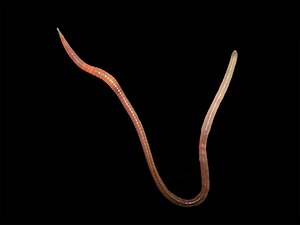Rhinodrilidae
| Rhinodrilidae | ||||||||||||
|---|---|---|---|---|---|---|---|---|---|---|---|---|

Pontoscolex corethrurus , native to Amazonia ( Guiana ), today invasive on other continents |
||||||||||||
| Systematics | ||||||||||||
|
||||||||||||
| Scientific name | ||||||||||||
| Rhinodrilidae | ||||||||||||
| Benham , 1890 |
Rhinodrilidae ( Synonym Pontoscolecidae James , 2012 ) is the name of a family of little bristles in the order of the Crassiclitellata (earthworms in the broader sense) that are common in Central America and South America . Until 2012, the species included in this were included in the Glossoscolecidae family .
features
The Rhinodrilidae have a cylindrical body without dorsal pores. On each segment there are four pairs of bristles , in some species - such as in the genus Pontoscolex - alternately closely and broadly paired in successive segments, rarely also numerous bristles, such as in the genus Periscolex .
The esophagus forms a chewing stomach in the 6th segment , while between the 7th and 14th segment there are calcareous glands in some or all of the segments outside the intestinal wall. The Typhlosolis is ribbon-shaped. In the front part of the body, the closed blood vessel system of the Rhinodrilidae has, in addition to the abdominal and dorsal vessels, a supra-oesophageal vessel constructed similarly to the latter, a pair of extra-oesophageal vessels in the middle of the heart and a subneural vessel adjacent to the body wall under the abdominal cord . The nephridia are probably developed as holonephridia with nephridiostomata, versicular in the midgut area.
The clitellum the hybrid is always saddle-shaped and receives, starting with the segment 14, up to 12 segments a. A pubertal tuberosity is present, and the inconspicuous male genital orifices, which are always located behind the female genital orifices as a pair, rarely (with Eudevoscolex ) 2 pairs, are usually within the clitellum, only rarely behind it (in opisthodrilus ), and are sometimes embedded in copulation bags . The animals have no prostates. The paired, adiverticulate (no blind sacs) receptacula seminis always open out in front of the gonad-bearing segments.
distribution
The Rhinodrilidae are distributed in Central America including numerous islands in the Caribbean and in tropical South America . The Rhinodrilidae, like other Crassiclitellates, are soil-dwellers and substrate-eaters , which digest the organic components of the ingested substrate. Preferred habitats are forest floors, but the species of the genus Pontoscolex are an exception as beach dwellers . The euryhaline species Pontoscolex corethrurus , which belongs to this, has now been brought to tropical regions of other continents by humans and is spreading as an invasive species on sea beaches, rivers and in their vicinity.
Systematics
The family Rhinodrilidae was established in 1890 by William Blaxland Benham , who, in addition to the genus Rhinodrilus , included annelids, which are now part of the families Microchaetidae , Hormogastridae and Glossoscolecidae . Since the establishment of the Glossoscolecidae family by Wilhelm Michaelsen in 1900, Rhinodrilus and the other genera mentioned here have been included in that family. Molecular genetic studies by Samuel Wooster James and Seana K. Davidson in 2012 showed that the Glossoscolecidae, as described by Reginald William Sims in 1981, are polyphyletic and must be divided into two new families, which is why they are the Glossoscolecidae s. st. newly described and the family Pontoscolecidae set up around the genus Pontoscolex . In the same year, however, Samuel Wooster James revised the name, since a family Rhinodrilidae including Pontoscolex had been founded as early as 1890 .
Genera
The family Rhinodrilidae has about 25 genera with approximately 200 species :
- Aicodrilus Righi, 1971
- Alexidrilus Righi, 1971
- Andiodrilus Michaelsen, 1900
- Andiorrhinus Cognetti, 1908
- Andioscolex Michaelsen, 1927
- Anteoides Cognetti, 1902
- Anteus Perrier, 1872
- Aptodrilus Cognetti, 1904
- Atatina Righi, 1971
- Aymara Michaelsen, 1935
- Botarodrilus Zicsi, 1990
- Bribri Righi, 1984
- Chibui Righi & Guerra, 1985
- Cirodrilus Righi, 1975
- Diachaeta Benham, 1886
- Estherella Gates, 1970
- Eudevoscolex Cordero, 1944
- Goiascolex Righi, 1971
- Hexachyloscolex Zicsi & Csuzdi, 1999
- Inkadrilus Michaelsen, 1917
- Irewiae Drachenberg, [1989] 1992
- Langioscolex Zicsi, 1990
- Maipure Righi, 1996
- Martiodrilus Michaelsen, 1937
- Meroscolex Černosvitov, 1934
- Nouraguesia Csudi & Pavliček, 2011
- Onoreodrilus Zicsi, 1988
- Onychochaeta Beddard, 1891
- Opisthodrilus Rosa, 1895
- Periscolex Cognetti, 1905
- Perolofius Righi & Nemeth, 1983
- Pontoscolex Schmarda, 1861
- Pseudochibui Drachenberg & Carlos, 1992
- Quimbaya Michaelsen, 1935
- Randdrilus Moreno & Pérez-Santos, 1997
- Rhinodrilus Perrier, 1872
- Tairona Righi, 1984
- Tamayodrilus Zicsi, 1995
- Thamnodriloides Gates, 1968
- Thamnodrilus Beddard, 1887
- Tuiba Righi, Ayres & Bittencourt, 1976
- Tupinaki Righi, 1996
- Urobenus Benham, 1886
- Zongodrilus Righi, 1996
literature
- Samuel Wooster James: Re-erection of Rhinodrilidae Benham, 1890, a senior synonym of Pontoscolecidae James, 2012 (Annelida: Clitellata). Zootaxa 3540, pp. 67-68.
- Samuel Wooster James, Seana K. Davidson (2012): Molecular phylogeny of earthworms (Annelida: Crassiclitellata) based on 28S, 18S and 16S gene sequences. Invertebrate Systematics, 26, 213-229. doi : 10.1071 / IS11012 .
- Reginald William Sims (1981): A classification and the distribution of earthworms, suborder Lumbricina (Haplotaxida: Oligochaeta). Bulletin of the British Museum (Natural History), Zoology Series 39 (2), pp. 103–124, here p. 111.
- Reginald William Sims, Brian M. Gerard (1981): Earthworms: Keys and Notes for the Identification and Study of the Species. Doris M. Kermack, RSK Barnes (Ed.): Synopses of the British Fauna (New Series), No. 31. EJ Brill, London 1985. p. 123.